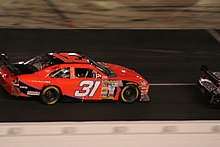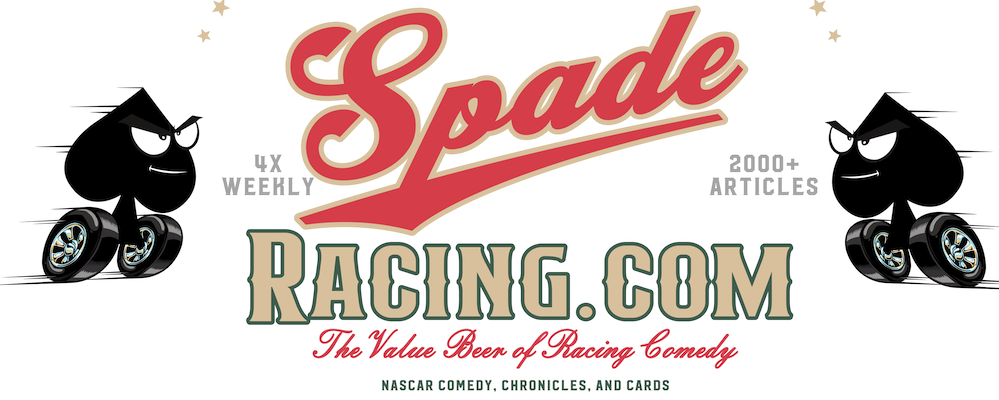 |
| Contingency decals, typically advertising "Official Nascar" sponsors |
Sponsorship is as important a part of Nascar as engines or pit stops. Oddly enough, there's no great central resource on the various quirks of this necessity of Nascar. That's where I come in!
 |
| BK Racing cars |
--Ever wonder why huge companies like Taco Bell or Burger King sponsor low-end teams like Front Row Motorsports or BK Racing? Well, its because technically, they don't. Teams like those instead sign “licensing agreements” with the big sponsors, in which they are paid a fraction of what a company would have to pay a top-flight team like Hendrick or Roush. Why? Well, those teams are owned by franchisees of their sponsors—Front Row owner Bob Jenkins is a major Yum! Brands franchisee, and BK Racing principal Ron Devine has several Burger King restaurants in his portfolio. Of course, with such (comparatively) little money coming in, those teams are glad to accept outside sponsors, even though they might not be nearly as well-known as their “sponsors” are (case in point: TMOne).
 |
| Haas-owned, Haas-sponsored |
--Of course, some teams are actually sponsored by a team owner's business, thus keeping the whole sponsorship game “in house”. Advantage: Much less sponsorship pleasing (meet & greets, commercials, etc.). Disadvantage: Much MUCH less money coming in. The best-known example of such a sponsor today is Furniture Row Racing, which is sponsored (obviously) by Furniture Row, owned by team owner Barney Visser. In 2014, they'll be joined by Stewart-Haas Racing's #41 car, sponsored by co-owner Gene Haas's Haas Automation. In the past, Jasper Motorsports lasted for years with primary sponsorship from Jasper Engines & Transmissions, while the team was owned by Jasper CEO Doug Bawel.
 |
| Ford EcoBoost on the hood |
--Today, teams will occasionally “fill-in” empty races with their own companies. Advantage: Avoids wasting a race with a blank hood, and promotes an in-house business. Disadvantage: Prospective sponsors might not realize you're looking. Examples of this are HendrickCars.com (Hendrick Motorsports), Dr1ven (Roush-Fenway Racing), Penske Truck Leasing (Team Penske), RK Motors (Michael Waltrip Racing), and Medallion Financial and VeriFone (Richard Petty Motorsports).
--Teams will also occasionally promote their manufacturers instead of running a sponsorless car. Ford usually promotes EcoBoost while Toyota has ToyotaCare. Chevy teams rarely run Chevy-sponsored cars.
--The past decade or so has seen the arrival of “wraps”--vinyl applications for the entire car, thus eliminating the need to paint a car each time there's a sponsorship change. This cuts down on cost and (especially) time, allowing for teams to have numerous sponsors throughout the year. Wraps allowed for one of the oddest arrangements in Nascar when Little Debbie sponsored teams. Little Debbie's parent company, McKee Bakeries, is owned by devout Seventh-Day Adventists, who refuse to advertise on their day of worship, Saturday. As a result, a Little Debbie-sponsored car would never run Little Debbie colors on a Saturday (race, qualifying, or otherwise). Here's a video of the Joe Gibbs Racing crew applying a wrap to Kyle Busch's Camry:
--Though most teams now use wraps for their cars, the term “paint scheme” is still used by many to describe the look of the car. A notable exception, however, is Jeff Gordon's #24. Since he's sponsored by Axalta Coatings (an automotive paint company, formerly part of Dupont), his car is still painted “the old-fashioned way” for each race.
--Nascar retains final say on the appearance of cars entered in any of its races. As a result, an unapproved
 |
| Jeff Burton's logo-less car |
sponsor can still “sponsor” a team, but Nascar can remove their logos from the car's paint scheme/wrap. The best-known example of this is Nascar's battle with AT&T and Richard Childress Racing. When Nextel (now Sprint) entered the sport, they requested exclusivity (see below) in the namesake Nextel (now Sprint) Cup Series. The two existing wireless communications provider sponsors in Cup at the time—Alltel and Cingular—were allowed to stay. However, when Cingular was rebranded as AT&T Wireless, Sprint objected. As a result, the #31 RCR car ran its normal paint scheme, but without logos (for AT&T) for several races. Other examples include Team Penske running an unbranded #12 car (due to sponsorship from Verizon Wireless), and Nascar rejecting sponsorship from RedneckJunk.com as offensive.
--Exclusivity for a title sponsor is nothing new in Nascar or motorsports as a whole. During Winston's long run as title sponsor of the Winston Cup Series, other cigarette companies were prohibited from sponsoring cars or races. In motorsports, such an agreement is known as a “Viceroy Clause”, supposedly after Viceroy brand-cigarettes first made the request to an open-wheel series in the 1960's.
 |
| The first special paint schemes |
--The first instance of a “special paint scheme”--running a different-than-usual look on a car for reasons other than a new sponsor—came in the 1991 Daytona 500, when Winston paid for five otherwise-unsponsored cars to run the colors of the US Military branches in support of Operation Desert Storm. The special paint scheme went from “fad” to big business, however, when Dale Earnhardt ran his famous silver-painted car during the 1995 Winston all-star race, in honor of Winston's 25th year sponsoring the series. Soon teams looked for any reason—a new movie, an anniversary, etc.--to run a different look in order to make (and, hopefully, sell) more merchandise, particularly die-cast cars. The practice has slowed down in recent years, as the advent of wraps has allowed teams to conceivably run a different paint scheme every week. However, the early special paint scheme merchandise continues to go for high-dollars to fans.
--The longest-running current association between a sponsor and a race team is Miller (beer) and Team Penske's #2 car. Since 1991 a Miller brand (first Miller Genuine Draft, then Miller Beer, then finally Miller Lite) has sponsored the #2 car.
 |
| A long-running PAINT scheme |
--The longest-running current association between a sponsor and a driver, meanwhile, is Jeff Gordon and Dupont/Axalta. Dupont first sponsored Gordon in his Cup debut, the famed 1992 season finale. Since then, Dupont has spun-off its performance automotive coatings business, forming Axalta, which continues to sponsor Gordon in several races each year.
--One way to make the search for a ride easier is to bring sponsorship with you. This is nothing new—in fact, it was Wrangler's sponsorship of Dale Earnhardt Sr. (as opposed to sponsoring directly with his team at the time) that allowed him to go to RCR.
--Of course, an even easier way to find sponsorship is to have a family-owned business be your sponsor. Examples of this today include: Brendan Gaughan (South Point Casino), Brian Scott (Shore Point Lodge), Justin Lofton (Lofton Cattle), and, of course, Paul Menard (Menards).
